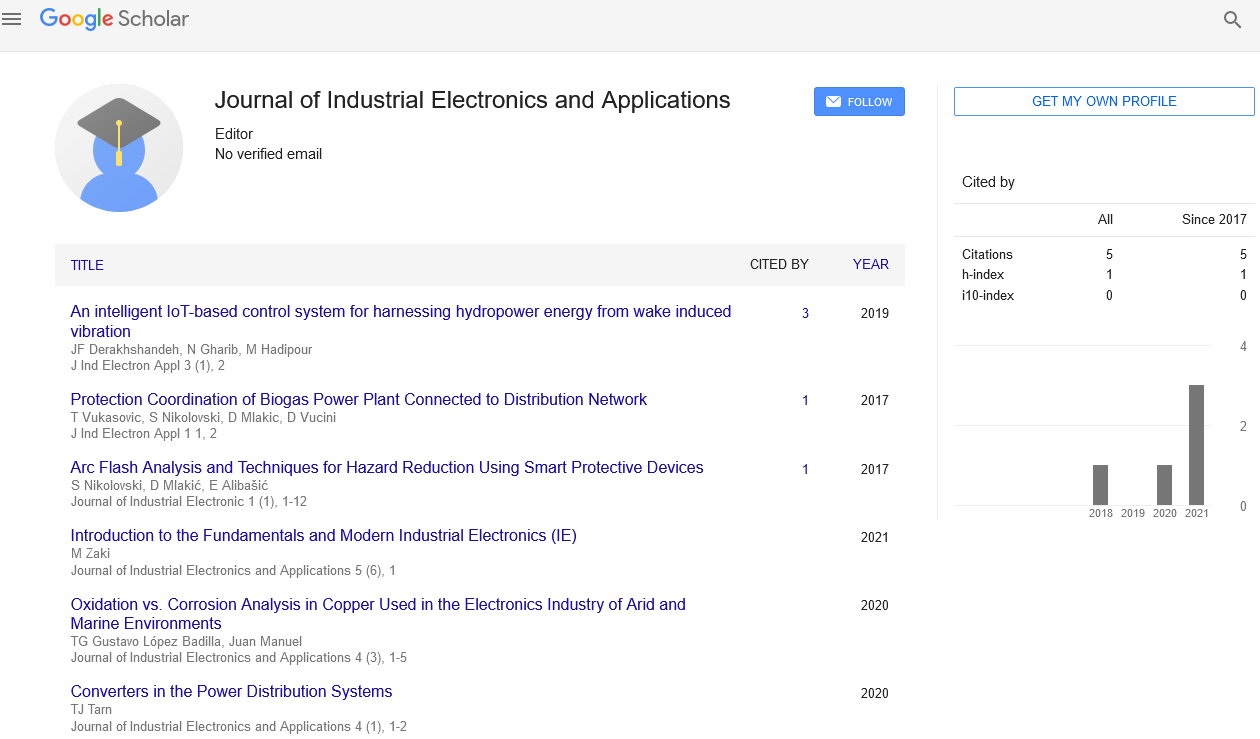Perspective, J Ind Electron Appl Vol: 7 Issue: 1
Power Electronics: A Technology for Efficient Energy Conversion
Frasnk Boulonie*
1Department of Power Electronics, University of Sherbrooke, Sherbrooke, Quebec, Canada
*Corresponding Author: Frasnk Boulonie
Department of Power Electronics,
Sherbrooke, University of Sherbrooke, QC, Canada
E-mail: Loniefras5656@gmail.com
Received date: 24 February, 2023, Manuscript No. JIEA-23-93575;
Editor assigned date: 28 February, 2023, PreQC No. JIEA-23-93575(PQ);
Reviewed date: 13 March, 2023, QCNo JIEA-23-93575;
Revised date: 21 March, 2023, Manuscript No. JIEA-23-93575 (R);
Published date: 30 March, 2023, DOI: 10.4172/JIEA.1000017.
Citation: Boulonie F (2023) Power Electronics: A Technology for Efficient Energy Conversion. J Ind Electron Appl 7:1.
Description
Power electronics is a technology that deals with the control and conversion of electrical power. This technology has become increasingly important due to the need for efficient energy conversion in various applications. This manuscript provides an overview of power electronics technology, its applications, and its benefits. The manuscript also discusses the challenges associated with power electronics technology and the future of this field.
Power electronics is a technology that deals with the conversion and control of electrical power. This technology has been used in various applications, including renewable energy systems, electric vehicles, power supplies, and industrial automation. Power electronics is essential for efficient energy conversion and has the potential to improve energy efficiency and reduce energy consumption.
Applications
Power electronics technology is widely used in various applications. One of the most significant applications of power electronics is in renewable energy systems. Renewable energy sources such as solar and wind power produce electricity in the form of Direct Current (DC), which must be converted into Alternating Current (AC) for use in the power grid. Power electronics technology is used to convert DC to AC and control the flow of electricity to ensure a stable and reliable power supply.
Another application of power electronics is in electric vehicles. Power electronics technology is used to control the power flow between the battery and the motor, ensuring optimal performance and efficiency. Power electronics also plays an important role in charging electric vehicles, as it is used to convert AC power from the grid into DC power for the battery.
Power electronics is also used in power supplies, which are essential for various electronic devices. Power electronics technology is used to convert AC power from the grid into DC power, which is then used to power electronic devices. Power electronics technology is also used in industrial automation, where it is used to control the speed and torque of electric motors, ensuring optimal performance and energy efficiency.
Benefits
Power electronics technology offers several benefits, including improved energy efficiency, reduced energy consumption, and reduced carbon emissions. Power electronics technology can improve energy efficiency by reducing the amount of energy lost during conversion and transmission. This can result in significant energy savings and reduced operating costs.
Power electronics technology also reduces energy consumption by providing a more efficient energy conversion process. This can help to reduce the demand for energy, resulting in a reduced carbon footprint and improved environmental sustainability.
Challenges
Despite the many benefits of power electronics technology, there are also several challenges associated with this field. One of the significant challenges is the complexity of power electronics systems, which can make them difficult to design, test, and maintain. Power electronics systems also require specialized knowledge and expertise, which can be a challenge for organizations that do not have the necessary resources.
Another challenge associated with power electronics technology is reliability. Power electronics systems must be designed and built to withstand harsh operating conditions, including high temperatures, humidity, and vibration. Failure of power electronics systems can result in significant downtime and repair costs.
Future of power electronics
The future of power electronics technology is bright, with many new developments and innovations on the horizon. One of the most significant trends in power electronics is the development of Wide Bandgap (WBG) materials such as Silicon Carbide (SiC) and Gallium Nitride (GaN). These materials offer several benefits over traditional silicon-based devices, including higher efficiency, higher power density, and higher switching speeds.
Conclusion
Power electronics is an important technology for efficient energy conversion in various applications. This technology offers several benefits, including improved energy efficiency, reduced energy consumption, and reduced carbon emissions. Another trend in power electronics is the development of modular power electronics systems. These systems are designed to be modular and scalable, making them easier to design, test, and maintain. Modular power electronics systems also offer improved reliability and reduced downtime.
 Spanish
Spanish  Chinese
Chinese  Russian
Russian  German
German  French
French  Japanese
Japanese  Portuguese
Portuguese  Hindi
Hindi 